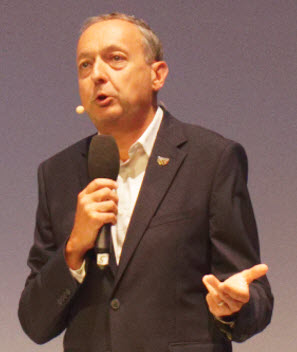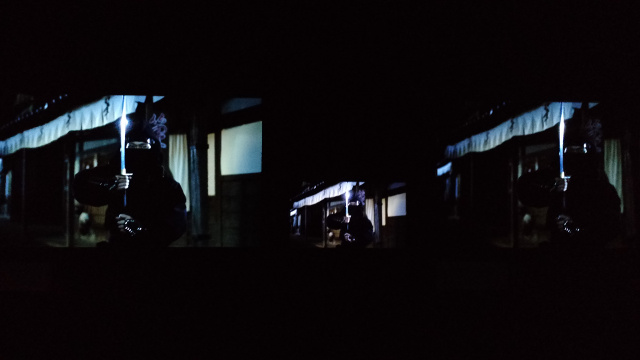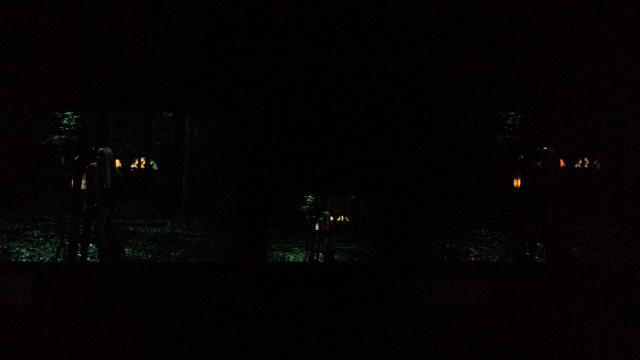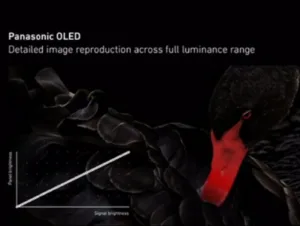Panasonic held its press conference as the first of the TV brands at IFA. Although the company is currently out of the market in the US, it is still present in Europe.
 Laurent Abadie is Chairman and CEO of Panasonic in Europe and he started by looking at the work that Panasonic is doing on “smart cities”. Smart cities will be a $.5 trillion market according to Deloitte, he said. Panasonic believes it is in an ideal position to support and exploit this. He has talked in the past about the Fujisawa project in Japan (Our LCD Will Compete With Plasma, Says Panasonic), inaugurated in 2014. Now, the company is looking more widely around the world for projects. Denver City Now is a 2016 project and is stronly supported by Panasonic. Smart Electronic Lyon is in France and is an energy project.
Laurent Abadie is Chairman and CEO of Panasonic in Europe and he started by looking at the work that Panasonic is doing on “smart cities”. Smart cities will be a $.5 trillion market according to Deloitte, he said. Panasonic believes it is in an ideal position to support and exploit this. He has talked in the past about the Fujisawa project in Japan (Our LCD Will Compete With Plasma, Says Panasonic), inaugurated in 2014. Now, the company is looking more widely around the world for projects. Denver City Now is a 2016 project and is stronly supported by Panasonic. Smart Electronic Lyon is in France and is an energy project.
Tsunashima is a new project aimed at reducing CO2, water and energy usage. It will be based on a hydrogen-based ecosystem. There is also a new project in Europe called “Future Living Berlin”.
Yuki Kusumi is from the Panasonic Appliances Company and he said that his plan is ‘making devices that are actually useful’. Panasonic is developing a robot that can wash, dry, store and fold. The firm plans to deliver by 2019 but in the mean time, the Laundroid folding robot should be available next year.
There is a new combination microwave oven using steam and new beauty products.
Finally, video
Finally after 35 minutes, Kusumi turned to video. 4K has been a big issue, but is not just about resolution, he said. The HC-X1 is a new 4K 50p/60p camcorder with a 1″ sensor. It has high picture quality, he said, from the combination of a Leica lens and Panasonic processing. Autofocus is a challenge in video, so there is a new microdrive auto focus especially for fast moving subjects. The camcorder will be on sale from December and includes an OLED viewfinder.
The UB-900 was both Panasonic’s and the market’s first UHD Blu-ray player in Eurpe and the new UB-700 will be available in October, but will still be UHD Alliance Premium certified. It has the same processor in the 700 as the UB-900 as well as HDR support. The processor maps 4:2:0 video from the Blu-ray to 4:4:4 on the display. The player has no analogue audio outputs, unlike the UB-900 and also loses the coax digital output, although there are dual HDMIs (one for audio) and optical audio output. It will sell for around €450 when it arrives and will compete with the current Samsung player.
 Panasonic Kusumi video – Image:Meko
Panasonic Kusumi video – Image:Meko
Moving to TV, the DX900 LCD TV has more than 1000 cd/m² of peak brightness and was introduced in Spring. It was Panasonic’s first UHD Premium label TV. KUsumi said that the company has now received “reference” awards from reviewers for its PDP, OLED and LCD TVs and is the first brand to achieve this. A video highlighted that the performance is based on panel choice, plus processing together with ‘tuning’ in Hollywood. Mike Sowa, a Hollywood colourist, uses the Panasonic CZ950 for grading (Panasonic Joins the Exclusive OLED TV Club). He also helped tune the DX900.
Now Panasonic is working on processing to improve the black level and near black detail of its OLEDs. OLED is the “most premium” TV product, Kusumi said, and is better than plasma but sometimes the very low black levels can get crushed. More information will be available ‘this winter’. Panasonic is fully committed to HDR throughout the company.
 Panasonic better blacks – Click for bigger image
Panasonic better blacks – Click for bigger image
Panasonic will soon (2018) celebrate 100 years of business and “has never been afraid to learn from others” (a Japanese boss used to call the firm ‘Copyshita’ so that may be true!)
There is a new technical collaboration with the Berliner Philharmoniker (BP) orchestra to update the Panasonic ‘digital concert hall’ experience and Olaf Maninger from the orchestra. The BP is also more than 100 years old, but has always been a pioneer of new technology and technical development. Apparently, Herbert von Karajan of the orchestra, ‘invented’ the musical CD (that will surprise Sony and Philips!). Currently the orchestra supports a streaming model with its own production company and which allows live access to the concerts. It works closely with Panasonic and will upgrade its studio to ‘4K’ with Panasonic.
The BP is re-introducing vinyl records and is pleased to be working with the Panasonic Technics brand on turntables (which are, apparently, currently sold out!)
New OLEDs Impress
Of course, we went around the booth.
The new OLED HDR panels that Panasonic was showing at IFA were perhaps the best we have seen to date. In a dark room, it was being compared to the current Panasonic OLED TV and the Sony X300 professional OLED monitor ($30K). Performance was nearly identical to the Sony monitor on the content being shown. The only noticeable difference was the slightly higher peak luminance of the X300 (1000 cd/m²) compared to the Panasonic display (800 cd/m²). Of particular note was the big improvement in the rendition of fine details in the darkest parts of the content. On the 2015 sets, there is a clear loss of detail that is quite visible on the 2016 panels and the Sony monitor. Panasonic also told us that the reproduction of green was improved, but when asked exactly what that meant, no answers were forthcoming. Panasonic has developed its own image processing engine however, and the quality of this engine shows.
The photos below show the new Panasonic TV on the left, the 2015 model on the right, and the Sony X300 monitor in the middle. In the top photo, note the glint from the sword is bright enough to over expose the camera, like the monitor in the middle, but not the 2015 model.
The bottom photo shows another dark scene with lots of fine detail visible in the left and middle display, but not in the right display (it’s a little hard to see in these photos and we were reluctant to process them too much, but much more apparent in real life).


Next spring, Panasonic said it will launch 55” and 65” curved OLED TVs using these improved panels and image processing. Pricing has not been announced, but is expected to be high for a TV, but inexpensive for a studio/mastering display.
Given the high quality of these TVs, with panels we assume are sourced from LG Display, we wondered if and when Panasonic might consider re-entering the US and China TV markets, from which it withdrew as PDP TV sales wound down? While we did not get an answer from officials at IFA, there was a report from Nikkei that said the company would indeed return to the North American and Asia TV markets in 2017 with OLED TVs, priced just above the LG pricing. This appears to be fuelled by a return to profitability for the company after years of losses on its TV operations. (the article also said that the current target for the firm is 6.4 million units during the financial year – 60% below its peak sales of fiscal 2010)
Panasonic currently sells in Europe the DX904 LCD TV with UHD resolution, HDR10 and UHD Alliance Premium Certification, plus the CZ954 OLED with UHD and HDR10.
The company was showing a side-by-side demo of HLG-based HDR compared to SDR – mostly to showcase the difference. No information on the set up was offered, however.
The company was also drawing a lot of attention for a demonstration of the transparent TV that it showed at CES. BR/CC

